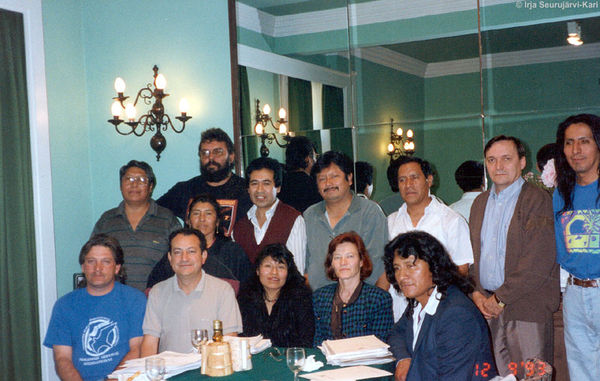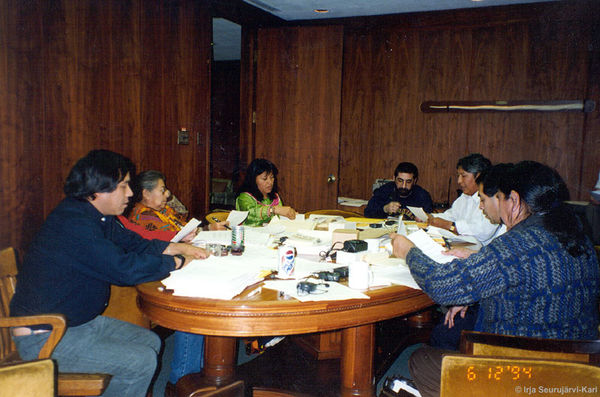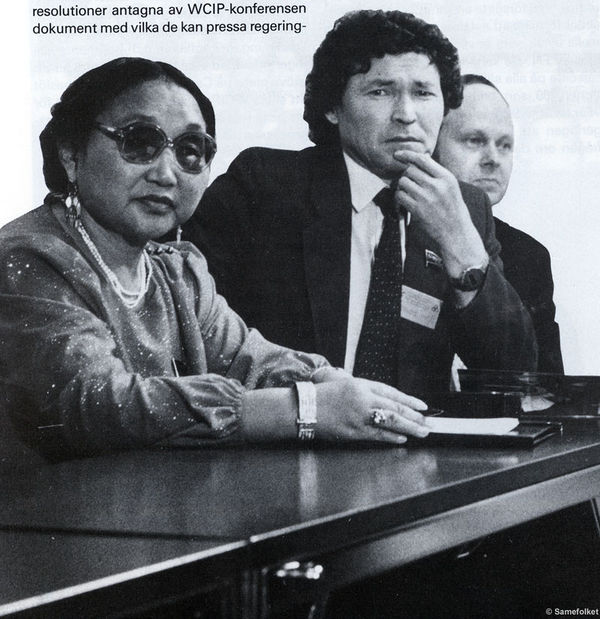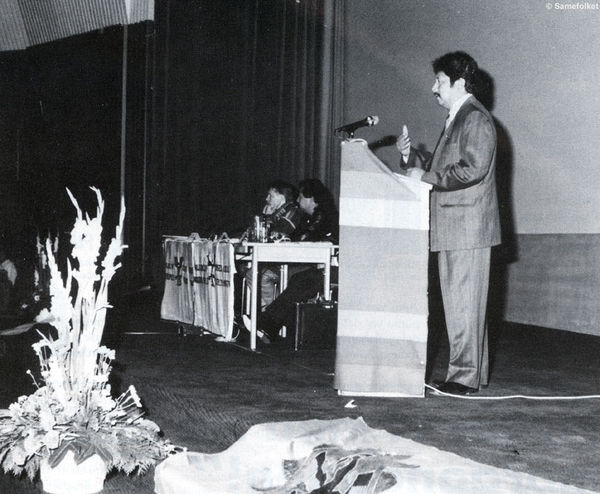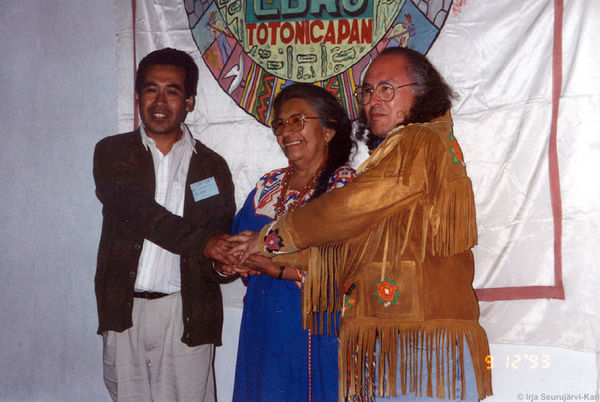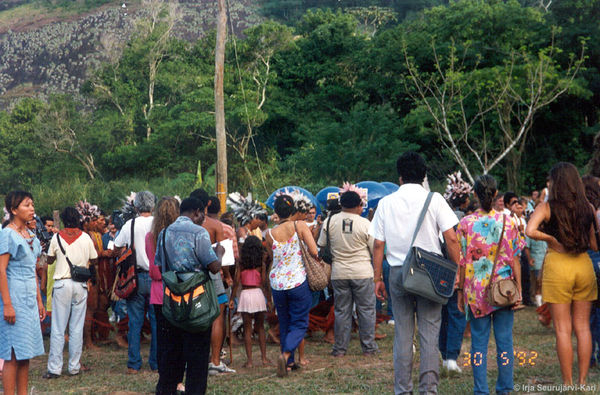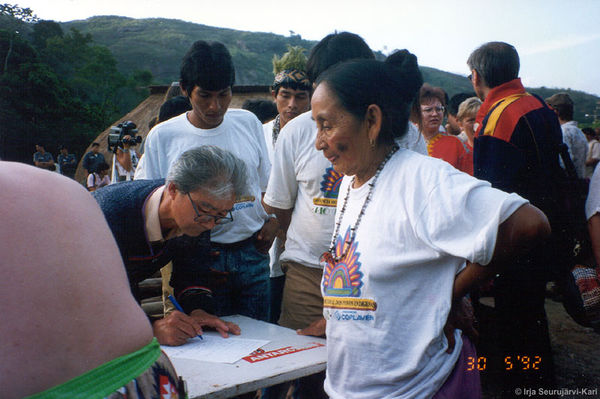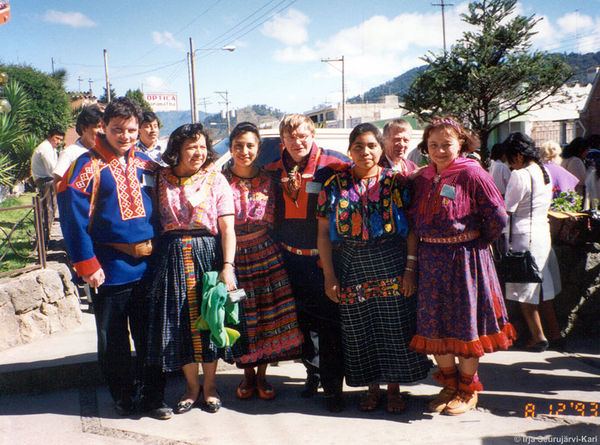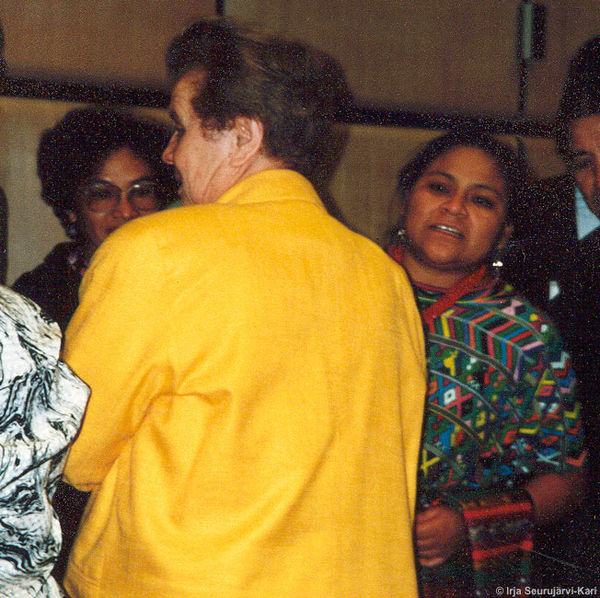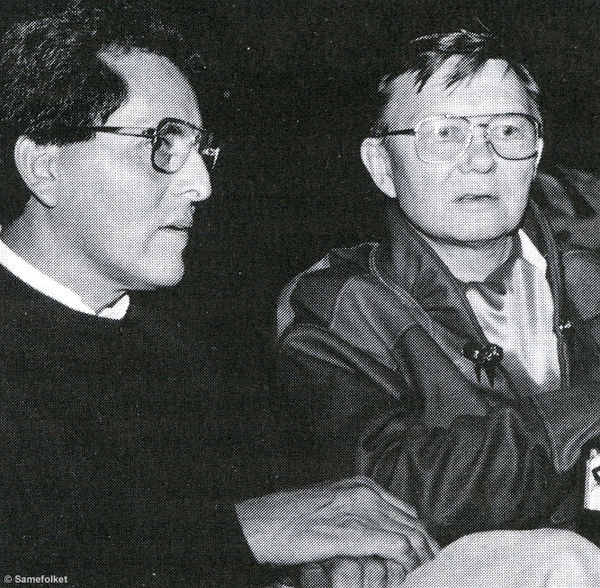World Council of Indigenous Peoples
Alkuperäiskansojen maailmanneuvosto
World Council of Indigenous peoples (WCIP) Álgoálbmogiid máilmmeráđđi. Alkuperäiskansojen maailmanneuvosto on alkuperäiskansojen omasta aloitteesta 1970-luvulla syntynyt kansainvälinen edunvalvontajärjestö. Maailmanneuvosto antoi sysäyksen maailman alkuperäiskansojen liikkeelle. Järjestön isänä pidetään kanadalaisen National Indian Brotherhood (NIB) -järjestön johtajana toiminutta George Manuelia. George Manuel järjesti lokakuussa 1975 Port Albernissa kansainvälisen konferenssin. Konferenssiin osallistui alkuperäiskansojen edustajia 24 maasta eri puolelta maailmaa, Amerikasta, Saamenmaasta, Grönlannista ja Australiasta. WCIP perustettiin tässä konferenssissa, jossa hyväksyttiin myös periaatteet sen toiminnalle. Konferenssissa WCIP:n tarkoitukseksi määriteltiin yhtenäisyyden vahvistaminen alkuperäiskansojen kesken, informaation välittäminen sekä kansallisten alkuperäiskansojen organisaatioiden voimistaminen. WCIP pyrkii mahdollisten fyysisten ja kulttuuristen kansanmurhien estämiseen, rasismin vastustamiseen, alkuperäiskansojen poliittisten, taloudellisten ja sosiaalisten oikeuksien turvaamiseen sekä nimenomaan alkuperäiskansoille kuuluvien oikeuksien, myös kulttuuristen oikeuksien, luomiseen ja vahvistamiseen. Maailmanneuvoston ensimmäiseksi presidentiksi valittiin luonnollisesti George Manuel. Maailmanneuvostosta muodostettiin alkuperäiskansojen kansainvälinen järjestö, jonka jäsenjärjestöjen tavoitteena tuli olla alkuperäiskansojen taloudellisen itsenäisyyden lisääminen ja itsemääräämisoikeuteen pyrkiminen.
Maantieteellisesti WCIP:n jäsenjärjestöt jaettiin viiteen mantereeseen; Keski- ja Etelä-Amerikkaan, Pohjois-Amerikkaan, Tyynen valtameren alueeseen, Karibian sekä Belizen alueeseen sekä Eurooppaan. Guatemalan yleiskokouksessa 1993 siirryttiin jaottelussa kymmeneen pienempään alueeseen, kuten Keski-Amerikkaan ja Panamaan, Andeihin ja Saamelaisalueeseen. Syynä tarkempaan aluejakoon oli pyrkimys maantieteelliseen edustavuuteen, joka näkyy myös järjestön rakennetta määrittelevissä säännöissä. Hallituksessa on jokaisella alueella edustaja. Presidentistä ja kahdesta varapresidentistä yksi valitaan Keski- ja Etelä-Amerikan alueelta ja yksi joltain toiselta alueelta. WCIP:n päämaja puolestaan on sijainnut Kanadassa, Ottawassa, mikä johtuu todennäköisesti George Manuelin ja NIB:n vahvasta roolista järjestön perustamisessa. Syyskuussa 1984 Panaman yleiskokouksessa hyväksytty julistus periaatteista esittää tiivistetysti tärkeimmät asiat ja tavoitteet, joihin WCIP pyrkii. Itsemääräämisoikeus, taloudelliset, sosiaaliset ja sivistykselliset oikeudet sekä maaoikeudet ovat merkittäviä WCIP:n periaatejulistuksen luettelemista oikeuksista.
,WCIP:n yleiskokouksia on pidetty kolmen-neljän vuoden välein eri mantereilla. Yleiskokouksissa valitaan hallitus sekä presidentti ja kaksi varapresidenttiä sekä luodaan maailman alkuperäiskansojen yhteisiä periaatteita ja päämääriä. Port Albernin jälkeen on pidetty seuraavat yleiskokoukset: 1977 Kiirunassa Ruotsissa, 1981 Canberrassa Kanadassa, 1984 Panamassa, 1987 Limassa Perussa, 1990 Tromssassa Norjassa ja 1993 Quetzaltenangossa Guatemalassa.
George Manuelia presidenttinä seurasivat Jose Carlos Morales Costa Ricasta vuodesta 1981, Clem Chartier Kanadasta vuodesta 1984, Donald Rojas Maroto Costa Ricasta 1987 ja Jorge Valiente Argentiinasta vuodesta 1993.
WCIP:n hallituksen kokouksia on pidetty kerran vuodessa. Hallitus valmistelee yleiskokouksia ja toimeenpanee sen päätöksiä sekä järjestää alueellisia ja kansainvälisiä kokouksia ja konferensseja. Hallituksen järjestämiä konferensseja on järjestetty yleensä YK:n suurten maailmankonferenssien yhteydessä.
WCIP:llä on neuvoa-antava eli NGO-kansalaisjärjestöstatus YK:n Sosiaali- ja taloustoimikunnassa (ECOSOC, Economic and Social Council), YK:n kasvatus-, tiede- ja koulutusjärjestössä (UNESCO, United Nations Educational, Scientific and Cultural Organization) ja Kansainvälisessä työjärjestössä (ILO, International Labour Organization). Se on myös kansainvälisten kansalaisjärjestöjen konferenssin (CONGO) johtokunnassa.
WCIP on toiminut aktiivisesti kansainvälisellä foorumilla, YK:ssa Alkuperäiskansojen työryhmässä, Ihmisoikeuskomissiossa, Kansainvälisen työjärjestön (ILO:n) istunnoissa Genevessä. Alkuperäiskansojen oikeuksien edistämiseksi pidetään tärkeänä myös kumppanuutta eri valtioiden ja eri kansainvälisten järjestöjen kanssa. Näitä ovat ACNUR-High Commission of the UN for Refugees (YK:n pakolaiskomissio); Project Consultant for Latin America Costa Rica (Latinalais-Amerikan neuvoa-antava projekti); Development and Peace, Kanada (Kehitys ja rauha); Anglikaaninen kirkko, Kanada; Kirkkojen maailmanneuvosto, Sveitsi; Episkopaalinen kirkko, Costa Rica; Calmeadow-Säätiö, Kanada; Kanadan kansainvälinen yhteistyöneuvosto eli Canadian Council for International Cooperation. 1980-luvulla WCIP:n yhtenä tärkeimpänä asiana oli edistää yhdessä muiden kansainvälisten toimijoiden kanssa ILO-sopimuksen nro 107 uudistamista ja sen lopullista hyväksymistä 1989. ILO:n sopimus 169 ja luonnosteluvaiheessa oleva alkuperäiskansojen oikeuksia koskeva julistus määrittelevät hallitusten velvollisuuksia alueillaan asuvia alkuperäiskansoja kohtaan, tosin vain harva hallitus on tähän mennessä ratifioinut sopimuksen 169. 1990-luvulla WCIP on ollut mukana useiden muiden kansalaisjärjestöjen kanssa YK:n alkuperäiskansojen oikeuksien julistuksen luonnostelutyössä Genevessä.
Maaoikeudet, ympäristökysymykset ja ihmisoikeudet kytkeytyvät tänä päivänä usein toisiinsa ja tämä koskee erityisesti alkuperäiskansoja. 1992 alkuperäiskansat kokoontuivat pitämään omaa kokoustaan Kari Ocaan lähelle Rio de Janeiroa viikon ajaksi ennen YK:n ympäristö- ja kehityskonferenssia.
Konferenssissa allekirjoitettiin Kari Oca -julistus, jossa keskeisenä asiana on kansojen oikeus itsemääräämiseen. Kari Oca -konferenssin tulokset tuotiin esille viikkoa myöhemmin alkaneessa YK:n ympäristö- ja kehityskonferenssissa. Järjestön edustajat ovat osallistuneet ihmisoikeuskonferenssiin Wienissä 1993 ja neljänteen naisten maailmakonferenssiin Pekingissä 1995. YK:n ihmisoikeuskonferenssissa hyväksyttiin muun muassa resoluutio alkuperäiskansojen vuosikymmenestä (1995-2004). Lisäksi alkuperäiskansojen edustajat vaativat pikaisesti valmistettavaksi vuosikymmenen toimintasuunnitelmaa, jotta vuosikymmenen merkitys ei jäisi pelkästään symboliseksi.
Naisten oikeuksien huomioiminen on myös tärkeää alkuperäiskansojen naisten kannalta, koska he usein kohtaavat syrjintää sekä etnisen alkuperänsä että sukupuolensa vuoksi. Naisverkoston perustamisesta WCIP:n sisälle päätettiin jo elokuussa 1990 Tromssan yleiskokouksessa, ja naisten asema oli esillä myös juuri ennen Guatemalan yleiskokousta pidetyssä naiskonferenssissa. Vuonna 1993 Quetzaltenangossa Guatemalassa järjestettiin kolme päivää kestänyt historiallinen naiskonferenssi. Quetzaltenagossa järjestelyistä vastasi C.D.R.O -niminen Maya-alkuperäisnaisten käsityöjärjestö.
Konferenssissa hyväksyttiin toimintasuunnitelma, jonka tavoitteena oli parantaa naisten osallistumismahdollisuuksia yhteiskunnalliseen toimintaan eri tasoilla. Naisten konferenssin saavutuksena voidaan pitää sitä, että järjestön historiassa ensimmäistä kertaa valittiin maailmanneuvoston puheenjohtajistoon nainen, Noeli Pocaterra Venezuelasta, wayuu-kansan edustaja. WCIP:n naiskonferenssi kuului maailmanlaajuiseen konferenssisarjaan ennen maailman neljättä naiskonferenssia Pekingissä. Naisverkoston on toiminut lähinnä konferenssien yhteydessä, ja vastuu siitä on ollut hallituksen naisjäsenillä.
Alkuperäiskansaliikkeen huippuhetkiä koettiin alkuperäiskansojen vuoden juhlaistunnossa YK:n yleiskokouksessa New Yorkissa joulukuun 10. päivänä 1992 sekä alkuperäiskansojen vuosikymmenenen avajaisissa 1994. Alkuperäiskansojen vuoden juhlallisuudet järjestettiin New Yorkissa, jossa alkuperäiskansojen edustajat pääsivät pitämään puheensa YK:n yleiskokouksessa. Juhlallisuuksista on ilmestynyt YK:n julkaisu A Seeds of a New partnership. Indigenous Peoples and the United Nation 1994, jonka esipuheen on kirjoittanut Rigoberta Menchú Tum, Nobelin rauhanpalkinnon saaja ja YK:n alkuperäiskansojen vuoden rauhanlähettiläs ja johdannon toinen alkuperäiskansojen asioiden suhteen tärkeä henkilö, Erica-Irene Daes, pitkäaikainen alkuperäiskansojen työryhmän puheenjohtaja.
Julkaisussa on alkuperäiskansojen järjestöjen edustajien17 puhetta sekä YK-systeemin oma osuus uuden kumppanuuden kunniaksi The United Nations System Responds to Indigenous Peoples' Needs ja Cultivating a New Pertnership: Indigenous Peoples in the International Arena. Loppusanat on kirjoittanut Ibrahima Fall, YK:n Ihmisoikeuskomission pääsihteeri ja vuosikymmenen koordinaattori. Liitteenä on ote Yleiskokouksen resoluutiosta 48/163: Maailman alkuperäiskansojen kansainvälinen vuosikymmen.
Järjestön toiminta on ollut aivan 90-luvun loppupuolelta asti hyvin hiljaista monestakin syystä. Ensiksi Kanada ilmoitti lopettavansa rahoittamasta maailmanneuvoston toimintaa yksinään, toiseksi jäsenjärjestöt alkoivat saada suoraa taloudellista tukea YK:lta kansainväliseen toimintaan, muun muassa osallistumiseen alkuperäiskansojen työryhmän vuosittaisiin kokouksiin. Jäsenjärjestöt olivat saaneet hyviä kokemuksia WCIP:ssä itsenäiseen vaikuttamiseen kansallisella ja kansainvälisellä tasolla. Positiivista on myös se, että monet WCIP:n hallituksessa toimineet ovat 2000-luvulla hakeutuneet valtakunnalliseen politiikkaan ja tulleet jopa valituiksi maittensa kansanedustuslaitoksiin, kuten WCIP:n varapuheenjohtaja Noeli Pocaterra Venezuelassa. Kolmantena pääsyynä toiminnan hiljenemiseen voidaan pitää sitä, että Panaman yleiskokouksessa aloitettu maailmanneuvoston sääntöjen uudistamistyö jäi keskeneräiseksi. Maailmanneuvoston olisi pitänyt pystyä vastaamaan uusiin haasteisiin nopeasti. Taloudellisesti heikko järjestö ei pystynyt uudistustyöhön, erityisesti koska jäsenjärjestöt katsoivat parhaaksi kohottaa vain omaa kansainvälistä profiiliaan. Eräänä syynä järjestön heikkenemiseen voidaan pitää saamelaisten poliittista epäonnistumista Tromssan yleiskokouksessa 1990. Saamelaisten tavoitteena oli ko. konferenssissa saada oma ehdokkaansa WCIP:n presidentiksi juuri heikentyneen tilanteen vuoksi, mutta saamelaisneuvosto epäonnistui pahasti hankkeessa muun muassa siinä, että nosti viime hetkellä esille kaksi ehdokasta yhden sijasta. Saamelaiset nähtiin ja edelleenkin nähdään alkuperäismaailmassa tarpeellisina jäseninä ja johtajina. Saamelaisten alkuperäinen syy liittyä järjestöön olikin osoittaa solidaarisuutta köyhimpien maiden alkuperäiskansoille ja pyrkiä saamaan resursseja järjestön toimintaan. Tromssan konferenssin saamelaisen valmistelukomitean puheenjohtajana toiminut Aslak Nils Sara sai yllättäen vastaehdokkaan saamelaisneuvostossa, ja siten hänen alunperin hyvät mahdollisuutensa nousta presidentiksi pilattiin.
Guatemalan yleiskokouksen jälkeen hallitus piti vielä useita kokouksia Kanadassa ja Pohjoismaissa lähinnä neuvotellakseen eri maiden hallitusten kanssa taloudellisesta tuesta, mutta melko laihoin tuloksin. WCIP:n hallitus teki rakentavan ehdotuksen järjestön uudistamiseksi. Hallituksen tavoitteena oli luoda yhteistyöjärjestö, joka harjoittaisi julkaisu- ja tiedotustoimintaa. WCIP:n luonnetta ja tulevaisuutta ajatellen sen toiminta keskitettäisiin kolmeen osa-alueeseen. Nämä osa-alueet koostuisivat lobbauksesta kansainvälisellä tasolla (hallitukset, yritykset sekä relevantit järjestöt), alkuperäiskansoille tärkeän tiedon levittämisestä, paitsi edellä mainituille tahoille myös alkuperäiskansoille itselleen, ja kolmanneksi koordinoivana elimenä toimimisesta. WCIP:n järjestörakenne voisi tällöin olla esimerkiksi verkostomainen, jolloin päämajasta ei tarvitsisi tehdä rakenteeltaan raskasta ja kustannuksiltaan kallista. WCIP:n päämaja on sijainnut Ottawassa Kanadassa vuoteen 1995. Nykyisin järjestöllä ei ole varsinaista toimistoa, mutta suunnitelmissa on perustaa tiedotustoimisto Geneveen.
WCIP:n toiminta on vastannut sen perustamisesta asti asetettuja tavoitteita ja on siten vaikuttanut voimakkaasti maailman alkuperäiskansojen yhteisten tavoitteiden ja yhteisymmärryksen vahvistumiseen. Järjestö on toiminut aktiivisena, arvovaltaisena alkuperäiskansojen puolestapuhujana ympäri maailmaa ja vaikuttanut alkuperäiskansojen ja heidän oikeuksiensa myönteiseen kehitykseen. Alkuperäiskansojen maailmanneuvoston vaatima kumppanuusperiaate muun maailmanyhteisön kanssa on nykyään vihdoin konkretisoitunut YK:ssa, sillä YK:iin on perustettu 2002 alkuperäiskansoja varten oma foorumi, ns. pysyvä foorumi. Alkuperäiskansojen järjestöt toimivat nykyään yhä aktiivisemmin alueellisella tasolla. Saamelaiset toimivat saamelaiskäräjien ja saamelaisneuvoston kautta arktisessa neuvostossa (ks. arktinen yhteistyö), Barentsin euro-arktisessa yhteistyössä ja Euroopan unionissa. Saamelaisilla on oman kulttuuri-itsehallintonsa myötä mahdollisuus vaikuttaa omaan tulevaisuuteensa, kieleensä ja kulttuuriinsa, mutta vielä nykyisinkin monet muut maailman alkuperäiskansat taistelevat vielä niiden ihmisoikeuksien puolesta, jotka saamelaisten kohdalla ovat jo toteutuneet.
Sisällysluettelo: Politiikka, järjestäytyminen ja organisaatiot
World Council of Indigenous Peoples
(WCIP) This organization was founded in the 1970s on the initiative of the world s indigenous peoples in order to protect their interests. It provided the impetus for the indigenous peoples movement. The father of the organization is considered to be George Manuel, the leader of the Canadian National Indian Brotherhood. In October 1975, he organized an international conference in Port Alberni, British Columbia (see pictures), in which representatives from 24 countries from different parts of the world, including America, Sápmi, Greenland and Australia, took part. The WCIP was founded at this conference, and the declaration of its principles was adopted in it. Its purpose was defined as the reinforcement of unity among indigenous peoples, the exchange of information and the strengthening of national organizations of indigenous peoples. The WCIP strives to prevent acts of physical and cultural genocide, to combat racism, to protect the political, economic and social rights of indigenous peoples and above all to create and reinforce the rights, including the cultural rights, of indigenous peoples. George Manuel was naturally elected the first President of the WCIP (picture). The WCIP was formed into an international organization, the aim of whose members was to increase the economic independence of indigenous peoples and work towards their self-determination.
The member organizations of the WCIP were divided geographically into five continents: Central and South America, North America, Oceania, the Caribbean and Belize, and Europe. In the General Conference in Guatemala in 1993, these areas were subdivided into smaller areas such as Central America and Panama, the Andes and the Saami area. The reason for this was an attempt to achieve adequate geographical representation, and this can also be seen in the regulations governing the structure of the organization. Each area is represented by one member on the Board of Directors. The President and one of the two Vice-Presidents are chosen from the Central and South American region and the other Vice-President from elsewhere. The headquarters of the WCIP is in Ottawa, which is probably a consequence of the major role played by George Manueli and the NIB in its foundation. A declaration of principles adopted in the 1984 General Conference in Panama outlines in concise form the most important issues and aims of the WCIP, among which the right to self-determination, economic, social and cultural rights and land rights are particularly significant.
The General Conferences of the WCIP have been held every three or four years in different continents. The General Conference elects the Board and the President and Vice-Presidents and draws up common principles and objectives for the indigenous peoples of the world. After the inaugural meeting in Port Alberni, the following General Meetings have been held: 1977 in Kiruna, Sweden; 1981 in Canberra, Australia (picture); 1984 in Panama; 1987 in Lima, Peru; 1990in Tromsø,Norway; and1993 in Quetzaltenango, Guatemala. George Manueli was succeeded as President by José Carlos → Morales (picture) from Costa Rica in 1981; Clem Chartier from Canada in 1984; Donald Rojas → Maroto from Costa Rica in 1987; and Jorge → Valiente from Argentina in 1993. The WCIP Board meets once a year. It makes preparations for the General Conferences and executes the decisions made in them. It also organizes regional and international meetings and conferences.
The WCIP has advisory status (i.e. that of anNGO) in the UN Economic and Social Council (ECOSOC), the UN Educational, Scientific and Cultural Organization (UNESCO) and the International Labour Organization (ILO). It is also represented on the board of the International Conference of Non-Governmental Organizations (CONGO). The headquarters of the WCIP was located in Ottawa, Canada until 1995.
The WCIP has also worked in the UN → Working Group on Indigenous Populations, the UN Commission on Human Rights and in the sessions of the ILO in Geneva. In order to promote the rights of indigenous peoples, the Council also considers it important to maintain partnerships with various states and international organizations such as ACNUR the High Commission of the UN for Refugees; the Project Consultant for Latin America in Costa Rica; the Development and Peace organization in Canada; the Anglican Church in Canada; the World Council of Churches in Switzerland; the Episcopalian Church in Costa Rica; the Calmeadow Foundation in Canada; and the Canadian Council for International Cooperation. In the 1980s, one of the prime goals of the WCIP was to cooperate with other international actors in furthering the reform of ILO Convention 107, which led to its final adoption in 1989. In the 1990s, the WCIP cooperated with numerous other non-governmental organizations (NGOs) in Geneva in drafting the UN Declaration on the Rights of Indigenous Peoples.
Today land and water rights,environmental issues and → human rights are interconnected, a fact which applies in particular to indigenous peoples. In 1992, the indigenous peoples of the world held their own week-long conference in Kari-Oca near Rio de Janeiro prior to the UN Conference on Environment and Development (UNCED). At the former conference, the → Kari-Oca Declaration was signed, the major assertion of which was the right of indigenous peoples to self determination. UNCED approved Agenda 21, which recognized indigenous peoples and their traditional knowledge of nature and the environment and demanded that it be included in the programmes and other measures of states and international organizations. Representatives of the World Council participated in the UN World Conference on Human Rights in Vienna in 1993 and in the Fourth World Conference on Women in Beijing in 1995. A resolution on an International Decade of the World's Indigenous People was adopted at the UN Human Rights Conference. In this conference, the representatives of indigenous peoples demanded an urgent plan of action for the decade in order that its significance should not remain merely symbolic. The declaration and plan of action adopted in the Vienna conference recognized the unique importance of indigenous peoples for the world s biodiversity and recommended that states respect the human rights of indigenous peoples according to the principles of equality and non-discrimination. It is noteworthy that particularly the ILO Convention on Indigenous and Tribal Peoples in Independent Countries (No. 169) and the Declaration on the Rights of Indigenous Peoples, which is at the draft stage, define the obligations of governments towards the indigenous peoples living in their territories, although few governments have ratified ILO Convention 169.
At the Beijing Conference, the representatives of the indigenous peoples adopted their own Declaration of Indigenous Women, which demanded that states take measures to promote and reinforce the rights of the women of indigenous peoples, including the right to participate in decision-making at different levels of society. The indigenous peoples' organizations were able to set their own common action objectives and strategies in the different conferences, which yielded some positive results. The acknowledgement of women's position is also important for the women of indigenous peoples because they are frequently subjected to discrimination not only because of their origins but also because of their gender. It was decided in the → Tromsø WCIP General Conference of 1990 to found a women s network. The position of women was raised at a historic three-day → WCIP Women s General Conference in Quetzaltenango, Guatemala in 1993. The organization of this conference was carried out by a Maya indigenous women's handicraft organization called C.D.R.O (picture). The conference adopted a plan of action with the aim of enhancing the opportunities for women to participate in decision-making at different levels of social activity. One achievement of the Women s Conference was the fact that for the first time a woman was elected as a Vice-President of the WCIP: Noeli Pocaterra (picture), a representative of the Wayuu people from Venezuela. The WCIP Women's General Conference was one of a worldwide series of meetings that were held prior to the Fourth World Conference on Women in Beijing. The work of the women's network has taken place mainly in connection with the conferences, and it has been the responsibility of the female members of the WCIP Board.
The highlights in the history of the indigenous peoples movement were the UN General Assembly's launching ceremony for the Year of Indigenous Peoples in New York on 10 December 1992 and the official opening of the Decade of Indigenous Peoples in 1994. In the formal ceremonies of the Year of Indigenous Peoples in New York, the representatives of the indigenous peoples made speeches (→Speech and picture of Donald Rojas, President of the WCIP) in the General Assembly. The formal ceremonies were commemorated with a UN publication: Seeds of a New Partnership. Indigenous Peoples and the United Nations (1994), the foreword to which was written by Rigoberta Menchu → Tum, the recipient of the Nobel Peace Prize and the UN Ambassador for Peace in the Year of Indigenous Peoples.
The introduction was written by another person who was highly significant in the affairs of indigenous peoples: Erica-Irene → Daes (picture), the long-serving Chairperson of the UN Working Group on Indigenous Populations. The publication also includes transcripts of seventeen speeches by representatives of indigenous peoples organizations as well as of those of representatives of the UN system. The conclusion was written by Ibrahima Fall, the Secretary General of the UN Commission on Human Rights and the coordinator of the International Decade of Indigenous Peoples. An extract from → Resolution 48/163 of the General Assembly (The International Decade of Indigenous Peoples) is included as an appendix.
From the end of the 1990s on, the activities of the organization have been very meagre for a number of reasons, the most important of which is probably the announcement of the Canadian government that it would no longer be solely responsible for financing the activities of the WCIP. Another important reason is probably the fact that the member organizations of the WCIP began to receive direct funding from the UN for their own international activities, including participation in the annual meetings of the Working Group on Indigenous Populations in Geneva,which enabled them to operate independently of the WCIP. The member organizations had, however, obtained positive experiences of exerting an independent influence within the WCIP at the national and international levels. It is also noteworthy that many of the persons who had served on the Board of the WCIP have in the present decade turned to national politics, and some, like the WCIP Vice-President Noeli Pocaterra in Venezuela, have even been elected to the parliaments of their respective countries. One reason for the decline in activity is perhaps the reform of the Council s rules, which was begun in the 1984 General Conference in Panama and dragged on to the end of the 1990s. The World Council should have been able to respond to new challenges swiftly , but the organization was economically weak and incapable of this, particularly when its member organizations were more interested in enhancing their own international profiles. One of the main reasons is the political failure of the Saami at the Tromsø General Conference in 1990. Their goal at that conference was to get their own candidate elected President of the WCIP. The Saami Council, under the auspices of which the Saami were members of the WCIP, failed in this endeavour, finding itself at the last moment with two candidates instead of one. In the Saami Council, Aslak Nils → Sara, who had been Chairman of the Organizing Committee of the Tromsø Conference, found himself competing against a surprise rival candidate, which spoiled his originally good chances of getting elected. The Saami had played a central role in the activities of the organization throughout its existence. After the Tromsø Conference, the WCIP Board under the presidency of Donald Rojas of Costa Rica continued its efforts to strengthen the organization.
After a General Conference held in Guatemala several meetings were held in Canada and the Nordic countries under the new President, Jorge Valiente, mainly to discuss financial support with the governments of various countries. However, the results were rather disappointing despite the fact that the WCIP Board made a constructive proposal for reforming the organization. The objective of the board was to create a new type of cooperative organization . The activities of the WCIP would focus on three areas; lobbying at the international level (governments, companies and relevant organizations); disseminating information that was of importance to indigenous peoples not only to these bodies but also to the indigenous peoples themselves; and thirdly acting as a coordinating organ for activities. The organizational structure of the WCIP might then be networked without the need for a structurally cumbersome and expensive headquarters. Today the organization has no actual office, but there are plans to establish an information bureau in Geneva
The activities of the WCIP have answered the aims that were set at its foundation, and it has played a very influential role in promoting the common objectives of the world s indigenous people and reinforcing mutual understanding. The organization has been an active and respected defender of indigenous peoples and a promoter of the successful development of their rights. The principle of partnership with the rest of the global community demanded by the World Council of Indigenous Peoples has finally been realized in concrete form in the United Nations, where a forum for the world s indigenous peoples, the so-called Permanent Forum, was established in 2002. The organizations of indigenous peoples today operate increasingly at a regional level. The Saami participate through the Saami Parliaments and the Saami Council in the Arctic Council, the → Barents Euro-Arctic Council and the European Union. With the advent of cultural self-determination, they have the opportunity to influence their own future and the survival of their language and their culture. Sadly, many of the world s indigenous peoples are still struggling to achieve these human rights.
Table of contents: Politics & Organizations
